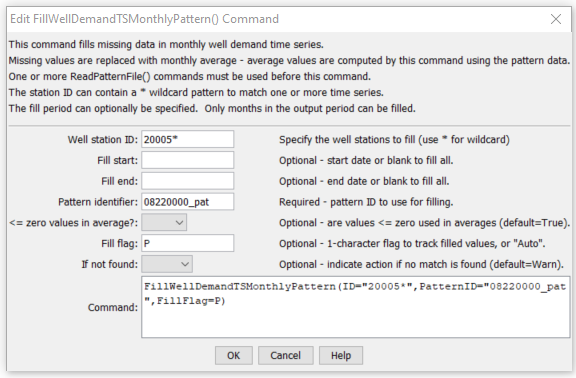StateDMI / Command / FillWellDemandTSMonthlyPattern
Overview
The FillWellDemandTSMonthlyPattern command (for StateMod)
fills missing well demand time series (monthly) data,
using average monthly wet/dry/average values.
The averages are computed using patterns read by the
ReadPatternFile command.
The average values that are used during data filling are printed to the log file.
For example, if a value is missing for May 1980,
the pattern for the specified pattern identifier is checked for WET, DRY, or AVG.
The values of all May’s for WET, DRY, or AVG are then averaged in the time series to be filled,
and the resulting average used to fill missing data.
This command therefore will result in filled values that are more appropriate than
simple averages; however, work must be done to characterize the wet, dry, and average months.
Command Editor
The following dialog is used to edit the command and illustrates the command syntax.

FillWellDemandTSMonthlyPattern Command Editor (see also the full-size image)
Command Syntax
The command syntax is as follows:
FillWellDemandTSMonthlyPattern(Parameter="Value",...)
Command Parameters
| Parameter | Description | Default |
|---|---|---|
ID |
A single well station identifier to match or a pattern using wildcards (e.g., 20*). |
None – must be specified. |
FillStart |
The first year to fill. | If not specified, fill the full period. |
FillEnd |
The last year to fill. | If not specified, fill the full period. |
PatternID |
The pattern identifier for data read with a ReadPatternFile command. |
None – must be specified. |
LEZeroInAverage |
Indicates whether values ≤ 0 should be considered when computing monthly averages. | True |
FillFlag |
If specified as a single character, data flags will be enabled for the time series and each filled value will be tagged with the specified character. The flag can then be used later to label graphs, etc. The flag will be appended to existing flags if necessary. | No flag is assigned. |
IfNotFound |
Used for error handling, one of the following:
|
Warn |
Examples
See the automated tests.
Troubleshooting
See the main troubleshooting documentation
See Also
FillWellDemandTSMonthlyAveragecommandFillWellDemandTSMonthlyConstantcommandReadPatternFilecommandSetWellDemandTSMonthlycommandSetWellDemandTSMonthlyConstantcommand